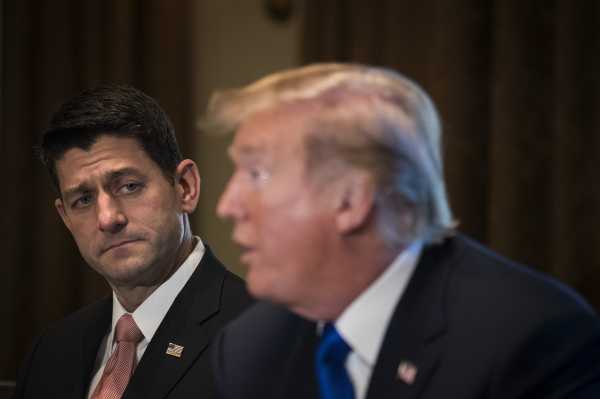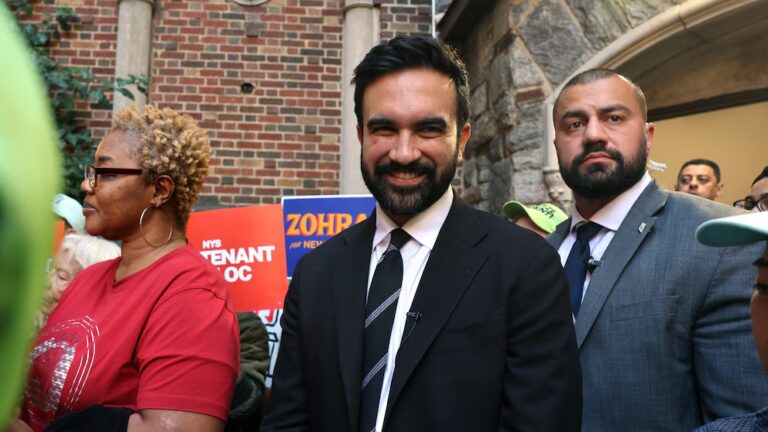
On Wednesday, the White House released a statement expressing President Donald Trump’s support for the omnibus, a $1.3 trillion funding package that would majorly boost military and domestic programs. Thirty-six hours later, Trump was threatening to veto the bill and shut down the government over Twitter.
He ultimately didn’t follow through, begrudgingly signing the omnibus Friday afternoon. But the apparent break down in the intervening hours opened a window into the Republican Party’s strategy with Trump: how congressional leaders try to keep business moving as usual under an extremely unusual — and often unpredictable — president.
To a degree, Trump’s frustrations with the spending bill were understandable; the final spending package ignored most of the White House’s hardline immigration agenda. It reined in funding for immigrant detention facilities, didn’t defund so-called “sanctuary cities,” and barely touched the border wall. Yet again, the deep ideological division between the White House and Republicans on Capitol Hill had reared its head.
But for nearly a day, House Speaker Paul Ryan sold Trump on everything else: a bill that would boost military spending, address the opioid crisis, and even put $1.6 billion toward border wall funding (the part about how all that money came with a lot of restrictions was likely left out of the pitch).
This is a story about how Republican leaders nearly failed to execute what has become a road-tested strategy with Trump: keeping him from reality.
Trump gave in this time. But he had a warning for Congress: “Never again.”
Republicans had to spin the spending bill not just for voters, but for Trump
On Wednesday afternoon, Ryan and Senate Majority Leader Mitch McConnell had been dispatched to sell the president on the spending bill. It was a success.
“The President and the leaders discussed their support for the bill, which includes more funds to rebuild the military, such as the largest pay raise for our troops in a decade, more than 100 miles of new construction for the border wall and other key domestic priorities,” White House press secretary Sarah Huckabee Sanders released in a statement shortly after the meeting.
That night, Trump declared victory on Twitter: He had won $1.6 billion in border wall funding and the biggest budget for the military in history. He griped about having to make wasteful spending concessions to Democrats, but it seemed like water under the bridge.
The next morning, Ryan went on Fox & Friends — one of Trump’s favorite morning shows, which he often live-tweets — reaffirming the president’s support.
“This is the Trump-Jim Mattis budget for the military,” Ryan said on air. “This funds the wall, fixes the military, fights opioids, does the things that we said and does not fund Gateway — gives Donald Trump the decision on Gateway.”
The strategy became clear: focus Trump on the military spending. Repeat the $1.6 billion number.
The reality, of course, was very different.
Sure, the spending bill does include some border wall funding — $1.6 billion worth (which is much less than the $25 billion the White House asked for) — but it comes with a lot of strings attached; most of the funding will have to go toward repairing existing fencing or toward double fencing where barriers already exist. In other words, this isn’t money for Trump’s big, beautiful wall. Overall, the spending bill largely dismissed Trump’s immigration agenda.
Yes, the $900 million infrastructure spending proposal for Gateway, a commuter rail and tunnel proposal connecting New York and New Jersey, which Trump threatened to veto the spending bill over, was left out — but there was more than $500 million in grants and Amtrak funding that could be allocated toward Gateway without the Department of Transportation’s stamp of approval.
How the “Trump-Jim Mattis budget” became the “swamp budget”
Ryan wasn’t on Fox & Friends Friday morning, and it showed. They had a very different message about the spending bill.
The omnibus was no longer the “Trump-Jim Mattis budget” for the military. It was the “swamp budget.” Fox contributor Pete Hegseth called it a “Mitch McConnell special.” He said there was “no wall” and that Democrats had taken over the process in the Senate.
We can’t say for sure that Trump was watching Friday morning. But that’s almost beside the point. The departure from Republican leaders’ spin was a show of the deep ideological divides within the Republican Party. Conservatives overwhelmingly came out against this spending bill for liberal spending on domestic programs and a lack of policy wins. It didn’t defund Planned Parenthood or sanctuary cities, and it didn’t prioritize school choice.
The Freedom Caucus, a group of the House’s most conservative lawmakers, called it an “insult to America’s taxpayers, as well as their many rank-and-file representatives who had no say in the omnibus negotiations.” Sen. Bob Corker (R-TN) a deficit hawk, called it “grotesque,” and Sen. John Kennedy (R-LA) took it one step further, saying the bill was a “great-dane-sized whiz down the leg of every taxpayer in this country.”
And as Vox reported last week, the White House, which often espouses the views of Congress’s most conservative hardliners, had increasingly grown dissatisfied with the spending bill over immigration. Trump officials had even been back-channeling conservative ideas with conservative allies on Capitol Hill. Needless to say, Trump’s base wasn’t going to like this spending bill.
By Friday morning, reality had set in once again. At 8:55 am, Trump was threatening a veto.
Trump says “never again”
Trump didn’t veto the spending bill.
After much drama, Trump promised to sign the funding package at a midday speech, averting a government shutdown.
But not without deriding the budget first. He called the spending fight a “ridiculous situation,” censuring Democrats for “wasting” money on domestic programs. He told Congress he would “never sign another bill like this again.”
“There are a lot of things I am unhappy about,” Trump said, calling for an end to the Senate filibuster, which gave Democrats leverage over spending negotiations — a move the fear of losing the majority keeps Republicans from doing.
In the end, Trump agreed to the funding package because of the military funding, saying his “highest duty is to keep America safe” (the bill gives the military its largest budget in history).
It was a narrow victory for congressional leaders, who have had little appetite for contentious policy fights — but one that exposed how they manage under Trump: It all depends on how effectively they can shield him from his base.
Sourse: vox.com






